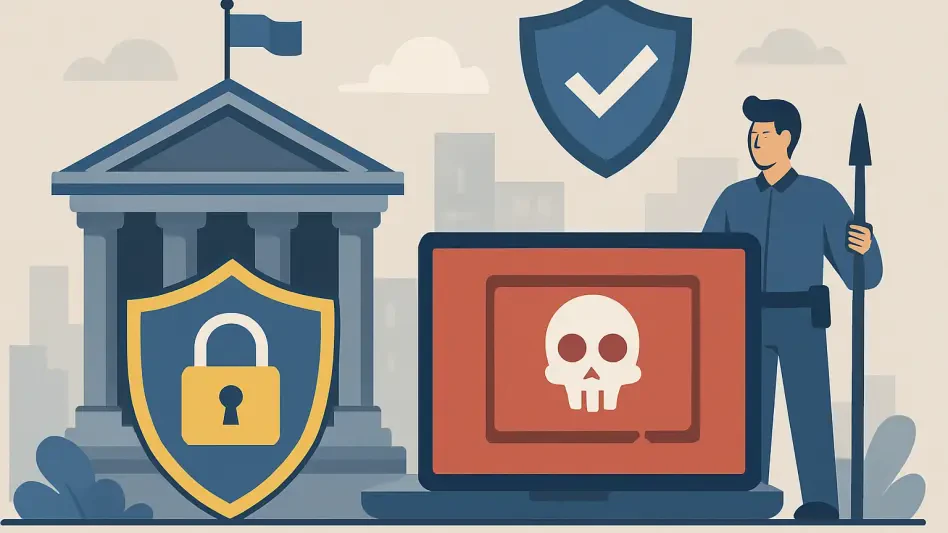This guide aims to equip government agencies, IT professionals, and cybersecurity teams with actionable steps to safeguard critical systems against ransomware attacks, using the recent breach at the Pennsylvania Attorney General’s (AG) office by the Inc ransomware group as a case study. By following this detailed framework, readers will learn how to identify vulnerabilities, implement robust defenses, and respond effectively to mitigate the devastating impact of such cyber threats. The objective is to build resilience against sophisticated attacks that disrupt operations and compromise sensitive data.
Why This Guide Matters
Ransomware attacks on government entities have surged to alarming levels, with a staggering 58 confirmed breaches in the United States this year alone, as reported by cybersecurity experts. The breach at the Pennsylvania AG office stands out, where the Inc ransomware gang allegedly stole 5.7 terabytes of data, marking it as one of the largest data thefts from a U.S. government entity to date. This incident, which began on August 11, disrupted critical operations and even led to the suspension of civil and criminal trials, underscoring the urgent need for enhanced cybersecurity measures.
The significance of protecting public institutions cannot be overstated, as they hold vast amounts of sensitive information and play a pivotal role in societal functions. A successful ransomware attack can paralyze operations, expose personal data, and erode public trust. This guide provides a roadmap to prevent such crises, drawing lessons from the tactics employed by groups like Inc, known for their spear phishing campaigns and exploitation of software vulnerabilities.
Beyond prevention, understanding how to respond to an attack is equally vital. Government agencies often face unique constraints, including limited budgets and outdated systems, making them prime targets for cybercriminals. By delving into the specifics of the Pennsylvania incident and broader ransomware trends, this resource aims to empower readers with knowledge and practical strategies to fortify their defenses against an ever-evolving threat landscape.
Step-by-Step Instructions to Secure Systems Against Ransomware
Step 1: Assess Current Cybersecurity Posture
Begin by conducting a comprehensive audit of existing security measures within the organization. This involves identifying all hardware, software, and network components to pinpoint potential weaknesses. In the case of the Pennsylvania AG office, outdated software or unpatched systems may have provided an entry point for the Inc group, a common tactic among ransomware gangs exploiting known vulnerabilities.
Engage IT teams to map out user access levels and review protocols for data storage and backups. Understanding where sensitive information, such as the 5.7 terabytes allegedly stolen in the Pennsylvania breach, resides is crucial. Regular vulnerability scans and penetration testing can reveal gaps before attackers do, ensuring that no stone is left unturned in safeguarding critical infrastructure.
Document findings and prioritize areas for improvement based on risk levels. Government entities often manage archived emails and legal documents, as seen in the stolen data from the AG office. A clear inventory of assets and their security status provides a foundation for targeted enhancements, reducing the likelihood of unauthorized access by malicious actors.
Step 2: Implement Robust Employee Training Programs
Educate staff on recognizing and avoiding spear phishing attempts, a primary method used by groups like Inc to infiltrate networks. Tailored training sessions should simulate deceptive emails that trick employees into clicking malicious links or downloading infected files, mirroring the likely initial entry tactic in the Pennsylvania incident.
Reinforce the importance of verifying email senders and reporting suspicious activity immediately. Continuous learning modules and periodic refreshers can keep cybersecurity top of mind, especially in under-resourced public sector environments where a single lapse can lead to catastrophic breaches. Empowering employees as the first line of defense is essential for prevention.
Incorporate real-world examples, such as how Inc’s tactics disrupted operations at the AG office by locking staff out of systems. Highlighting the tangible consequences of phishing—such as trial suspensions until mid-September—can drive home the stakes involved. A well-informed workforce significantly reduces the risk of human error, a common exploit in ransomware schemes.
Step 3: Update and Patch Systems Regularly
Ensure all software, operating systems, and applications are updated with the latest security patches. Ransomware groups often target outdated systems, a vulnerability possibly exploited during the attack on the Pennsylvania AG office. Establish a routine schedule for updates and automate the process where possible to minimize oversight.
Allocate resources to replace legacy systems that no longer receive vendor support, as these are particularly susceptible to attacks. Budget constraints in government agencies can delay such upgrades, but the cost of a breach, like the operational paralysis seen in Pennsylvania, far outweighs proactive investment. Timely updates are a critical barrier against known exploits.
Monitor alerts from software providers and cybersecurity agencies for emerging threats. Swift application of patches can close windows of opportunity for attackers, preventing scenarios where malware locks systems and steals data simultaneously, as Inc did with their dual-threat approach. Staying ahead of vulnerabilities is a non-negotiable step in modern defense strategies.
Step 4: Strengthen Network Security with Advanced Tools
Deploy advanced firewalls, intrusion detection systems, and endpoint protection to secure network perimeters. The Inc group’s ability to steal data and encrypt systems at the AG office highlights the need for multi-layered defenses that detect and block unauthorized access in real time. These tools act as a digital shield against sophisticated intrusions.
Implement strict access controls and multi-factor authentication for all users, especially those handling sensitive data. Limiting permissions reduces the blast radius if a breach occurs, a lesson from the widespread system lockdown experienced by the Pennsylvania staff. Segregating networks can further isolate critical areas from potential compromise.
Regularly test these security measures through simulated attacks to identify weaknesses. Investing in threat intelligence services can provide insights into tactics used by gangs like Inc, who have a history of targeting government entities with 22 confirmed attacks among their 126 verified breaches. A fortified network is a formidable deterrent to cybercriminals.
Step 5: Develop and Test an Incident Response Plan
Create a detailed incident response plan that outlines steps to take during a ransomware attack, from detection to recovery. The Pennsylvania AG office’s experience, where operations were halted and data was posted on leak sites, illustrates the chaos that ensues without a clear strategy. Define roles and communication channels for swift action.
Conduct regular drills to ensure all team members understand their responsibilities in a crisis. Testing the plan under realistic conditions can reveal flaws, such as delays in notifying affected individuals, a current challenge for the AG office. Preparation minimizes downtime and reputational damage when an attack strikes.
Include protocols for engaging external cybersecurity experts and law enforcement, as well as guidelines on ransom payment decisions. The AG office’s refusal to pay, as stated by Attorney General Dave Sunday on August 29, reflects a principled stance, but each scenario requires tailored evaluation. A robust plan ensures resilience under pressure.
Step 6: Establish Secure Data Backup Practices
Maintain regular, encrypted backups of all critical data, stored offline or in isolated environments. The massive theft of 5.7 terabytes from the Pennsylvania AG office underscores the importance of having recoverable copies of sensitive information, such as legal files and archived communications, to avoid total loss.
Test backup restoration processes frequently to confirm data integrity and accessibility. Government agencies often handle irreplaceable records, and the operational disruptions in Pennsylvania show the consequences of inaccessible systems. Reliable backups enable quicker recovery without succumbing to ransom demands.
Secure backup systems with stringent access controls to prevent attackers from targeting them. Inc’s strategy of dual data theft and encryption, as seen in their attack, means backups must be protected as rigorously as primary systems. A strong backup regime is the backbone of any ransomware recovery effort.
Final Thoughts on Building Cyber Resilience
Looking back, the journey through assessing vulnerabilities, training staff, updating systems, fortifying networks, preparing response plans, and securing backups provides a comprehensive shield against ransomware threats. These steps, inspired by the severe breach at the Pennsylvania AG office, offer practical ways to counteract the sophisticated methods of groups like Inc. Each action taken builds a stronger defense, reducing the risk of operational paralysis and data exposure that plagued the affected agency.
Moving forward, government entities must consider ongoing investments in cybersecurity as a priority, not an afterthought. Exploring partnerships with federal programs or private sector experts can bridge resource gaps, ensuring continuous improvement in protective measures. Staying vigilant about emerging threats and adapting strategies accordingly will be key to preventing future incidents.
Additionally, fostering a culture of transparency around cyber incidents can enhance public trust and encourage collective learning. Agencies should prepare for potential delays in notifying affected individuals, as seen in the Pennsylvania case, by streamlining communication processes. By committing to these next steps, public institutions can transform challenges into opportunities for lasting security enhancements.








